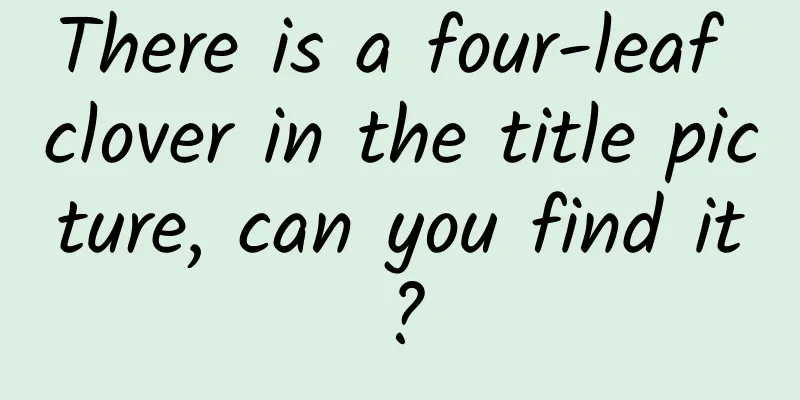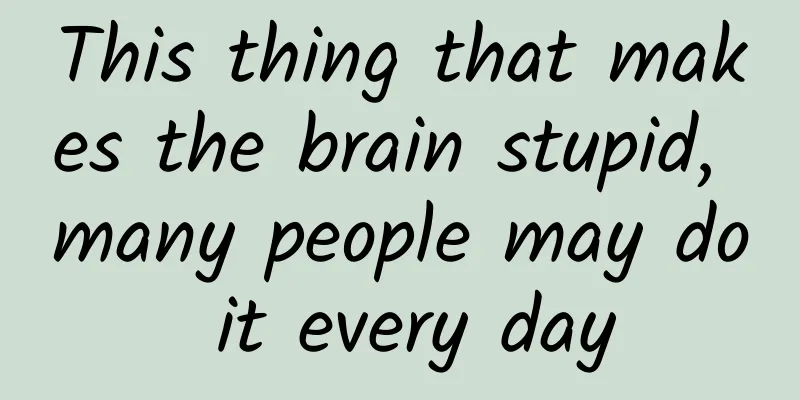There is a four-leaf clover in the title picture, can you find it?

|
There is a three-dimensional four-leaf clover hidden in the picture below. Can you see it? The three-dimensional pattern hidden in the picture There are more similar pictures here. Why not try to find out what three-dimensional patterns are hidden in the pictures? (Please share the patterns you see in the comment section~) This is the once popular 3D Stereogram. Some people can see the mystery at a glance, while others can't figure it out no matter how hard they try (yes, that's me). To understand the principle, we must first know how our eyes see three-dimensional objects? 01 How do people see three-dimensional objects? Stereoscopic vision is an advanced skill for our eyes to see things. The shadow of an object falls on the retina of our left and right eyes, just like two friends reporting to the brain separately. Once the brain integrates, we can feel the three-dimensional world. Because the two eyes are separated by a distance, when looking at the same object, the images on the two retinas will be slightly different, which is called parallax. It is because of this difference that we can distinguish the distance of objects and have a three-dimensional sense. Binocular disparity map Image source: Reference [1] Doctors usually use a device called a synoptophore to check our three abilities to see things: simultaneous vision, fusion vision, and stereoscopic vision. Through this device, doctors can know if there is a problem with our visual function. Synopter Image source: Photographed by the author There are specially designed pictures in the synoptophore to test whether our stereoscopic vision is good or not. The test result is called stereoscopic acuity. Stereoscopic acuity is the smallest depth difference we can feel. The image size seen by both eyes is about the same, which is the basis for normal vision. Synoptophore test picture source: taken by the author 02 How do three-dimensional paintings present a three-dimensional effect? Three-dimensional stereoscopic paintings are masters of parallax, simulating three-dimensional visual effects through two-dimensional images. They are usually made with computers, creating a bunch of meaningless repetitive patterns in the horizontal direction. In the 1990s, with the development of computer graphics and neuroscience, three-dimensional stereoscopic paintings spread rapidly. When we look at three-dimensional stereoscopic paintings, we need to adjust the observation lines of the left and right eyes at the same time, and adjust the position of the convergence point of the two lines of sight accordingly. Only when the convergence point is adjusted to the appropriate position can the hidden three-dimensional effect be discovered. Magic Eye, a 3D magazine popular in the 90s Image source: Xiaohongshu user Based on parallax, the brain can perceive the spatial three-dimensional sense of the picture. The three-dimensional images in the picture sometimes seem to jump out of the picture and stand out in front of the eyes, and sometimes seem to be hidden deep in the picture, adding a sense of space and depth to the image and presenting a multi-level, multi-dimensional visual effect. Schematic diagram of the three-dimensional image protruding in front of the screen Schematic diagram of the three-dimensional image hidden deep in the picture Image source: Zhihu 03 Why can’t some people see the 3D effect? To see an object in three dimensions, the vision of both eyes must be balanced and the images seen must be roughly the same. Only in this way can the brain integrate the images seen by both eyes and give people the perception of depth. If the vision of the two eyes is not balanced, for example, one eye sees things blurry, or the objects seen by both eyes are different sizes, the brain has difficulty integrating these images and the three-dimensional perception disappears. There are many reasons for uneven vision, one of the most common is anisometropia, which means that the degree of the two eyes differs too much. Anisometropia not only makes the eyes tired, but in severe cases it can also cause double vision or even cause one eye to "go on strike". In this case, the development of stereoscopic perception of both eyes will be seriously affected. Amblyopia is another case. It is caused by problems in the area of the brain that processes visual information. Although the eye itself may not be a problem, the vision still cannot function normally. Amblyopic patients not only have blurred vision, but also reduced resolution ability. It is difficult for the two eyes to work together, and the sense of stereo is naturally out of the question. Everyone has different tolerance for the difference in binocular vision, so the performance of stereoscopic perception will also vary from person to person, some are clear, and some are more blurred. Image source: Photo Network Sometimes, different people may see different images of the same three-dimensional painting. Each of us has different eye conditions. Some are nearsighted, some are farsighted, and some have astigmatism. These differences not only affect the clarity of our vision, but also affect the three-dimensional sense and color perception. Not only that, our sensitivity to color is also different, so when appreciating the same painting, the perception of color will also be different. Color itself has a magical "magic" - it can help us judge the distance of objects. Generally speaking, warm colors (such as red and orange) look closer to us, while cool colors (such as blue and green) appear farther away. In addition, as we age, our eyes will gradually "age", the establishment of three-dimensional sense will become slower and slower, and the clarity of seeing things will be much worse than before. author: Zheng Xiaohong, PhD candidate in biology and medicine, master of optometry, chief ophthalmologist at the optometry center of the Affiliated Eye, Ear, Nose and Throat Hospital of Fudan University; Zheng Ke, deputy director of the Education Department of the Affiliated Eye, Ear, Nose and Throat Hospital of Fudan University, associate chief physician Planning & Editing: Rain Picture source: The three-dimensional paintings in this article come from the App [Sight がみるみる上がる3D Vision Reply アプリ] |
<<: Curling: From "Stonehenge" to "Rounded Little Boy"
>>: Flu ≠ Cold! Here’s how you should deal with the often-ignored flu →
Recommend
Can the former Android giant, which has suffered consecutive losses, return to its glory by relying on these businesses?
I believe that in recent days, everyone must have...
Is the virus strain prevalent in Beijing more virulent than that in Guangzhou? Authoritative interpretation →
The new coronavirus variants currently prevalent ...
How much does it cost to be an agent for a moving app in Beihai?
How much does Beihai's moving agency app cost...
The most "depressing" Double 11 copy is here, you will laugh like crazy after reading it!
The annual big shopping festival is here again, a...
Cleverly use leverage to attract 1 million users
How to define seed users ? Three conditions for d...
How to make a WeChat travel booking app and a scenic spot booking app?
With the rise of WeChat mini-programs, new develo...
“Pull out one grey hair and 10 will grow back”, is it true?
White hair always lurks on our heads silently. If...
Why can I finish two bowls of rice after swimming, but have no appetite after running?
Review expert: Shen Yingjian, Director of the Nut...
VR helps Mango TV's "Super Girl" technology makes the content more vivid
For the technology circle, VR can be regarded as ...
Faith and the Cage, a documentary about Steve Jobs
[[149041]] “A churchman without empathy” That’s w...
Finally supports personalized ringtones and HD videos! WeChat new version experience
WeChat has been updated. In this update, we can f...
Tips for cold-starting short video community content!
The short video community is dominated by content...
Just look at the restaurants nearby and you will know that the dealers selling home appliances are very happy.
Some time ago, "Midnight Diner" became ...
UDesign - [Jia Jia Jia] A Beginner's Guide to Color Matching for Commercial Illustrations
UDesign - [Jia Jia Jia] Commercial Illustration C...









